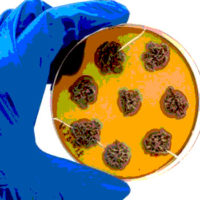A Look at Top Trends in Food Chemistry

 Although bacterial contamination is traditionally identified by consumers as their primary food safety and quality concern, there is a wide variety of other potentially detrimental compounds and quality issues that must be supported by comprehensive analysis programs (Figure 1). Many of these, such as chemical residues, have been analyzed for decades. However, interest in others, such as genetically modified organisms (GMOs) and indirect additives from packaging, is relatively recent. Today, there are several key analytical trends that will have an integral effect on a food product's success and reputation in the marketplace. These include:
Although bacterial contamination is traditionally identified by consumers as their primary food safety and quality concern, there is a wide variety of other potentially detrimental compounds and quality issues that must be supported by comprehensive analysis programs (Figure 1). Many of these, such as chemical residues, have been analyzed for decades. However, interest in others, such as genetically modified organisms (GMOs) and indirect additives from packaging, is relatively recent. Today, there are several key analytical trends that will have an integral effect on a food product's success and reputation in the marketplace. These include:
• Agricultural chemicals Biotechnology
• Carcinogens
• Direct food additives
• Packaging and indirect food additives
• Antibiotic and drug residues
• Allergens
• Traditional nutrients
• Phytochemicals and micronutrients
• Regulatory initiatives
The ability to respond to ever-evolving consumer attitudes, regulatory initiatives and scientific discoveries requires that the food manufacturing industry keeps its finger on the pulse of key safety concerns and the analytical methodologies required to monitor product safety, functionality and quality.
Accent on Agrochemicals
Although agricultural practices have drastically changed in recent decades, the threat of harmful pesticide residues in foods remains a major concern, especially given the advent of the global marketplace. Initiatives for worldwide harmonization of residue assays and tolerance levels have resulted in validated methods for many classes of compounds. Using a variety of chromatographic techniques, low-cost and high-throughput screens that can detect hundreds of pesticides for less than $1 per compound have been adopted. If a pesticide is detected, confirmatory analysis using additional chromatographic or mass spectrometry (MS) techniques are often done to provide more comprehensive data. A food matrix may contain hundreds of natural or man-made chemicals that can potentially interfere with the analytes of interest. As a result, the method used must take advantage of the analyte's physical and chemical properties to facilitate detection of the analyte from the matrix-derived interferences.
Most pesticide residue procedures involve separation using gas chromatography (GC), high-performance liquid chromatography (HPLC), or liquid chromatography (LC). Before separation, samples are subject to extraction and cleanup, which facilitates separation of the pesticide from the matrix and helps purify the extracts for quantification. After separation, residues are measured using a detection device, such as a mass spectrometer. The use of LC/MS techniques has grown significantly due to the increased availability of the instrumentation. This combination of separation and detection devices allows less stringent cleanup, minimizes the effects of interferences and, in some cases, allows the elimination of the confirmation step.
The Burdens of Biotechnology
Perhaps no topic in recent years has initiated as much consumer angst and global discord as the use of transgenic technology for developing disease- and pesticide-resistant plants, as well as enhancing beneficial nutritional and compositional qualities. As a result some foods and botanical ingredients are tested first to determine if altered genes are present and if so, to establish nutritional and compositional equivalency with standard commodities.
A number of methods have been developed to quickly and effectively screen products for the presence and amounts of bioengineered ingredients. These include a lateral flow test, which is a qualitative assay for use on corn and soy samples and a polymerase chain reaction (PCR) screen used to detect the presence of the cauliflower mosaic caulimovirus 35S promoter. The enzyme-linked immunosorbent assay (ELISA) is used to detect the Cry9C protein, which has been incorporated into insect-resistant corn, as well as Roundup Ready soybeans. The restriction digest confirmation assay is validated for a number of GMOs, including 35S, NOS and StarLink.
A key to consumer and regulatory acceptance of biotechnology derived products is ensuring that these products are equivalent in nutritional and compositional content to existing conventional varieties. To make these evaluations, samples are obtained from the harvest of several different field test sites and compared to control and reference products and to published research. Samples are analyzed to determine the levels of nutrients, antinutrients (i.e., toxins), and other components (e.g., ash, moisture and fiber). Testing includes routine nutritional assays, as well as specialized analyses such as residue screening for specific compounds, or measures for elevated levels of a particular toxin.
The Concern about Carcinogens
Although much of the research on cancer-causing agents in foods has focused on synthetic chemicals (e.g., preservatives, colorants), cancer-causing chemicals that occur naturally in foods are far more numerous in the human diet. For example, there are approximately 300 known nitrosamines in foods and more than 90% of these are known to be carcinogens, mutagens or teratogens. Several vegetables--beets, celery, lettuce, cabbage and spinach--contain notable of amounts of nitrate. Although nitrate itself has not been found to be carcinogenic, it can be converted in the human body into nitrite, react with other chemicals (e.g., amines, amides) and produce nitrosamines.
Other prominently occurring carcinogens include mycotoxins, such as aflatoxin and fumonisin, which are produced by fungi that grow on peanuts, corn and other grains. In addition, several other potentially carcinogenic compounds are monitored by food companies, including the hydrazine family in mushrooms, pyrrolizidine alkaloids in herbal teas, and tannins found in coffee, tea and red wines. Although test kits for on-site detection of some toxins (e.g., Salmonella, E. coli) are available, new mycotoxins are being discovered constantly. For comfirmatory testing, HPLC or thin layer chromatography (TLC) are the methods of choice.
Although the topic of the development of carcinogenic compounds in cooking and processing first surfaced in the 1960s in relation to nitrosamines in cured meat products, this issue once again rose to prominance with publication of studies on acrylamide in 2002. Scientists were quick to respond with a LC/MS method for acrylamide detection and quantification. However, the data on acrylamide have raised the specter that processing of other food products may produce potentially harmful compounds.
Direct Food Additives
Although deciphering the U.S. Food and Drug Administration (FDA) regulations on food additives can be disconcerting, it is essential that manufacturers understand the status of additives under the "generally recognized as safe" (GRAS) exemption and recognize to what extent testing is required. Title 21 of the Code of Federal Regulations now lists more than 200 additives that have been designated as GRAS for specific uses. Under these rules, a food manufacturer must get FDA approval before using a new additive or before using a previously approved additive in a new way or in a different amount. The approval process for a new additive is a complex process, involving studies to demonstrate that the additive is safe for consumers, to identify the cumulative effect in the diet, and to determine the potential toxicity of the additive when ingested by humans or animals. With the trend toward replacement of synthetic chemicals with natural components (e.g., organic acids) and the development of ingredients such as "designer fibers," manufacturers must thoroughly investigate an ingredient's regulatory status. For international markets, issues such as Japan's complete ban on synthetic colorants must be taken into consideration.
Testing to confirm levels of GRAS additives should be a routine facet of the quality control process. Due to the broad range of compounds involved, a diverse array of methodologies are used including traditional chemistry techniques (e.g., gravimetric), as well as more sophisticated instrumental methods. For example, the FDA method for synthetic colors in unsweetened powdered soft drink mixes uses a combination of TLC and reverse phase liquid chromatography (RPLC) for quantitative measurements of all the major Federal Food, Drug & Cosmetics Act (FD&C Act) colorants.
Perspectives on Packaging and Indirect Additives
Packaging is an integral component of a product, designed not only to keep the good stuff in and the bad stuff out, but also to discourage tampering, promote convenience and add to market visibility. Unfortunately, as the innovative design of packaging changes, there is a corresponding effect on the regulatory and experimental guidelines for determining the impact of packaging components on the safety of food and dietary products. The primary concern is the migration of indirect additives from packaging that can cause health concerns and adversely affect the taste, color and aroma of foods. Migration testing is done to identify potential classes of migrating substances (e.g., colorants, plasticizers), the composition of the food, temperatures to which the product and packaging are exposed, and the length of time of exposure. In the case of dietary supplements and botanicals, migration could potentially have a negative effect on the efficacy of the active ingredient.
Through the use of approved food-simulating solvents and specialized extraction cells, scientists can compile a quantitative description of the substances that transfer from the food contact material into the food. These data enable researchers to ensure that if substances approved as GRAS are present, they are at or below acceptable levels. In addition, these data enable identification of any components that have not been approved. The study design is based upon a comprehensive understanding of the intended use of the food contact material, synthesis and manufacturing of the material, and the raw materials used in its construction.
Diagnosing Drug Residues
In recent years there has been growing concern over the potential effects of ingestion of drug residues from products derived from animal sources. This concern has been accentuated based upon the belief that as the bacteria develop resistance to antimicrobial drugs in animals, they can promote emergence of resistance in bacteria that may not be pathogenic to the animal but are to humans (e.g., Salmonella, Campylobacter, and E. coli).
The FD&C Act specifies that when determining the safety of a new animal drug, the FDA must consider the probable consumption of such a drug and any substance formed in or on food and the cumulative effect on humans. As a result, the FDA requires sponsors of all new antimicrobial animal drugs intended for use in food-producing animals to provide information that will allow the agency to evaluate the human health impact of the intended use. Due to the nature of the matrix, measurement of drug levels in tissue and fluids is extremely challenging and requires special facilities, expertise and equipment. These challenges are even more acute in light of the desired limits of detection in the low parts-per-billion (ppb) range that are required in order to meet consumer desire of zero tolerance.
Assessing Allergens
The concern about allergens is quickly becoming one of the most visible and urgent issues facing the food industry and the identification of the "Big 8" food allergens has been front-page news. The issue is not only one of ensuring that derivatives of common food allergens are included on labels, but also ensuring that manufacturing facilities and equipment used for multiple products do not contribute to misbranded products. Allergic reactions to food products primarily are due to specific proteins.
As a result, immunoassays such as ELISAs are widely used for detection. The immunoassay is based on the protein's characteristic of binding to specific enzyme labeled antibodies, thereby allowing detection and quantification by comparison to standard curves. Currently, these tests are performed primarily in the laboratory; however, low-cost test kits that can be used in the manufacturing plant are currently being validated and evaluated by the FDA. Instrumental techniques utilizing LC/MS may be used in highly sensitive situations.
A New Refrain for the Old Standards
The foundation of the nutrition labeling and consumer education revolution was the labeling of traditional nutrients such as vitamins, minerals, fat and carbohydrates. Now, after more than a decade of compliance with the National Labeling and Education Act (NLEA) requirements, the testing process and methodologies are well established. However, as more information about specific nutrients becomes available (e.g., vitamin E) and consumer attitudes change (e.g., trans fat), manufacturers are seeking analyses for these compounds at trace levels. In addition, many products are being fortified with nutrients, which poses challenges and modifications to existing methods due to potential interferences in the matrix.
Consumers also are increasingly interested not only in levels of nutrients, but in the quality of the components. For example, in many cases, the amount of protein present in a food is not as important as the quality and bioavailability of that protein. As a result, a complete amino acid profile or protein digestability assay may be beneficial. The form of certain vitamins is important, as well. The Recommended Daily Allowance (RDA) for vitamin E, for example, is based on the alpha-tocopherol form because it is the most bioavailable. Unlike other vitamins, the form of alpha-tocopherol made in the laboratory and found in supplements is not identical to the natural form, and is not quite as active as the natural form.
Scientists also are sometimes asked to monitor for detrimental levels of some compounds. For example, recently enacted Canadian labeling regulations specify upper limits for vitamins and minerals in meal replacement products. For analysis of heavy metals, inductively coupled atomic emission spectrometry is used to screen for the presence of metals at minute levels.
Phytochemicals and Micronutrients
The nutraceuticals explosion of the 1990s resulted in clamor for validated methods for many previously ignored or seldom-considered components. Al-though plagued by a lack of reference standards and historical data, researchers have now developed reliable methods for many beneficial (e.g., catechins) and detrimental (e.g., aristolochic acid) compounds. In many cases, a key to method development was the design of the extraction process in which the sample is purified and analytes that may interfere with detection are removed. The HPLC is the instrument of choice for a majority of the compounds in question. A variety of detection systems are employed including mass spectrometry and ultraviolet (UV) detection.
Advances in methods for many of these compounds are being accelerated through the work of a task force organized through the auspices of AOAC International with support from the FDA, the National Insitutes of Health (NIH) and many industry organizations. Because the FDA specifically cites AOAC methods as preferred for regulatory compliance (21 CFR 2.19), the assays approved by this group will have a significant impact on the testing programs required for a variety of compounds, including artistolochic acid, beta carotene and ginsenosides.
Responding to Regulatory Initiatives
Despite the popular view that regulatory agencies often lag behind scientific and consumer trends, 2003 has been a record year for new regulations and initiatives. The finalization of the trans fat labeling rule, the move toward qualified health claims and proposed Good Manufacturing Practices (GMPs) for dietary supplements are a few of the more recent regulations issued. Each of these will have a dramatic effect on the extent of testing required for regulatory compliance and desired from a marketing standpoint.
Although the new trans fat rule will not allow the use of terms such as "trans fat free," it will allow a label claim of "zero" if the product contains less than 0.5 g per serving. As a result, the testing criteria must take low levels of detection under consideration. Certainly, the ability to build consumer knowledge through the use of the expanded qualified health claims will result in increased testing for previously unlabeled components. Manufacturers should also be looking at the proposed GMPs for dietary supplements and consider the possible ramifications for "functional food" products.
When asked about the apparent inability of regulations to keep pace with science, renowned food industry lawyer George Burditt responded, "It is important to remember that regulations are set in stone and after passage it is hard to split the stone. It is not essential that regulations catch up to science; however, it is imperative that they don't hinder it." This viewpoint underscores the importance of the food industry, consumers and scientists collaborating with regulators to initiate testing and education programs. These programs will be successful if they are not based solely on governmental mandate, but truly founded upon a commitment to a safe and healthy supply of food and dietary products.
Rick Crowley is senior science writer with Covance, Inc.
Looking for a reprint of this article?
From high-res PDFs to custom plaques, order your copy today!





